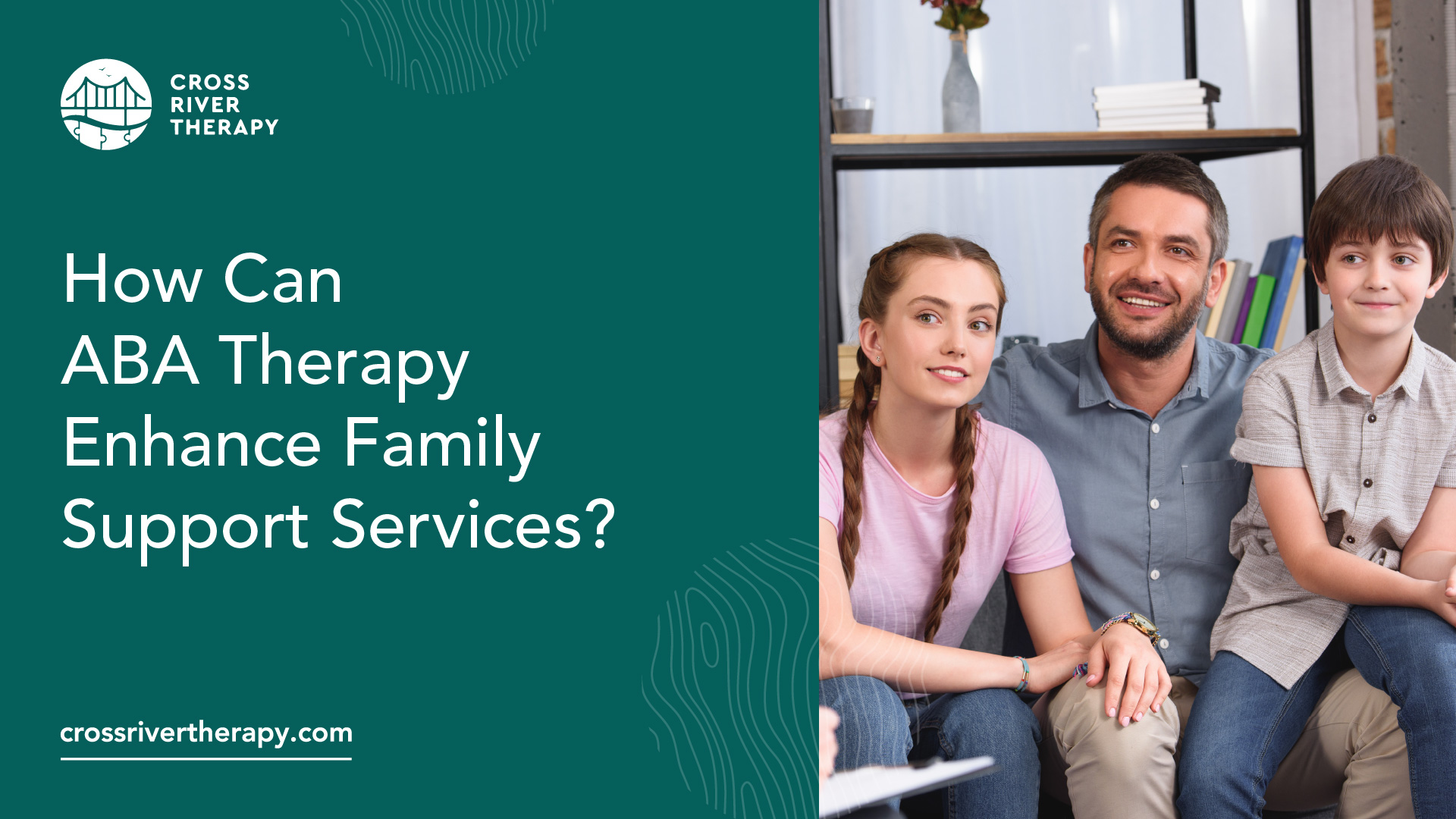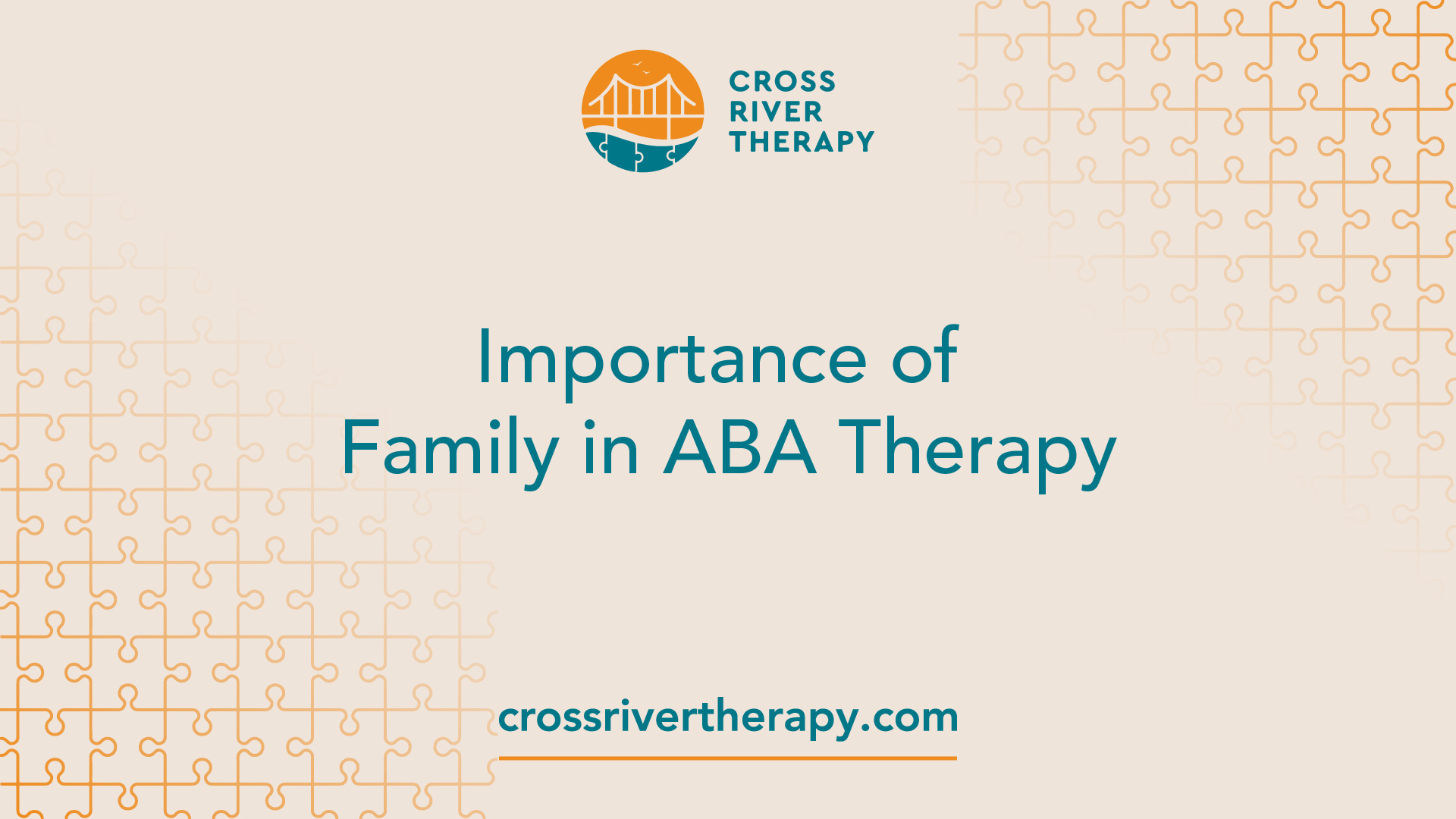How Can ABA Therapy Enhance Family Support Services?
Explore how ABA therapy integrates with family support services to enhance overall family dynamics and support.

Understanding ABA Therapy
ABA therapy, short for Applied Behavior Analysis, is a widely recognized and evidence-based approach to treating individuals with autism and related developmental disorders. This section provides an overview of the basics of ABA therapy and explores its origins.
Basics of ABA Therapy
ABA therapy is rooted in the principles of behavior science and focuses on enhancing behavior by applying techniques derived from the science of behavior. The term "applied" in ABA denotes making socially significant changes in individuals' behaviors.
By targeting challenging behaviors and teaching new skills, ABA therapy aims to improve the overall quality of life for individuals with autism.
The process of ABA therapy typically involves the identification of specific behaviors to be addressed, followed by the development of a personalized treatment plan.
This plan utilizes strategies and interventions based on the principles of behavior analysis to modify behaviors and teach new skills. ABA therapy is often implemented in various settings, such as home, school, or clinical environments, to ensure consistent and comprehensive support.
ABA therapy employs a range of techniques to address behaviors and promote skill development. These techniques include:
- Discrete Trial Training (DTT): DTT involves breaking down complex tasks into smaller, more manageable steps and using repetition and reinforcement to teach new skills effectively.
- Antecedent-based Interventions (ABI): ABI focuses on modifying the environment and antecedent events to prevent or minimize challenging behaviors from occurring.
- Parent-implemented Intervention (PII): PII involves training and empowering parents to implement ABA techniques and strategies in daily routines to promote skill acquisition and behavior management.
ABA therapy is highly individualized, taking into account the unique needs and goals of each individual. The treatment plans are developed based on comprehensive assessments and ongoing data collection to track progress and make necessary adjustments.
Origins of ABA Therapy
ABA therapy has a rich history dating back to the 1960s, when psychologist B.F. Skinner developed a theory of operant conditioning, which focused on altering consequences to control behavior. Skinner's work laid the foundation for the principles and practices that form the basis of ABA therapy today.
Since its early beginnings, ABA therapy has evolved and expanded, becoming a widely recognized and recommended treatment for individuals with autism. It has gained recognition as an evidence-based best practice treatment by the US Surgeon General and the American Psychological Association.
Numerous studies have demonstrated the effectiveness of intensive and long-term ABA therapy in improving outcomes for children with autism.
By understanding the basics and origins of ABA therapy, families can gain insight into this proven approach and make informed decisions regarding the best support for their loved ones with autism. ABA therapy, when implemented with fidelity and tailored to individual needs, has the potential to bring about significant positive changes in behavior and skill development.
Key Techniques in ABA Therapy

ABA therapy utilizes specific techniques to provide effective interventions for individuals with autism. These techniques are designed to address behavioral challenges and promote skill development. Here are three key techniques commonly used in ABA therapy:
Discrete Trial Training (DTT)
Discrete Trial Training (DTT) is a fundamental teaching strategy in ABA therapy. This technique involves breaking down skills into small, manageable elements and systematically teaching them one at a time.
During a discrete trial, the therapist or parent presents a specific instruction or question to the child and prompts or guides them to respond correctly. Positive reinforcement is provided immediately after each correct response, helping to reinforce the desired behavior.
The structured nature of DTT allows for repetition and practice, which helps individuals with autism acquire new skills. By breaking skills into smaller components, it becomes easier for the child to understand and respond. DTT is particularly effective in teaching foundational skills such as language, social interactions, and self-help skills.
Antecedent-based Interventions (ABI)
Antecedent-based Interventions (ABI) focus on modifying the environment to reduce triggers for interfering behaviors [2]. This technique involves identifying and altering the antecedents or events that occur before a behavior of concern.
By manipulating the environment, ABI aims to prevent challenging behaviors from occurring in the first place.
One example of ABI is offering choices to reduce defiance. By providing options and allowing the individual to make a decision, it empowers them and decreases the likelihood of challenging behaviors. ABI techniques can also involve modifying routines, providing clear instructions, and creating structured environments that promote positive behavior.
Parent-implemented Intervention (PII)
Parent-implemented Intervention (PII) is a crucial component of ABA therapy, recognizing the importance of family involvement in the therapy process [2]. In PII, parents and caregivers are trained and actively participate in implementing ABA interventions with their child.
This approach has been shown to be highly effective for children on the autism spectrum.
By involving parents and caregivers, ABA therapy extends beyond the therapy sessions and becomes an integral part of the child's daily life. PII empowers parents to facilitate desired behavior and positive changes in their child.
Through training and collaboration, parents learn strategies to support their child's progress, reinforce learned skills, and manage challenging behaviors. This involvement allows for consistent implementation of interventions, resulting in greater generalization and maintenance of skills.
By employing techniques like DTT, ABI, and PII, ABA therapy provides individuals with autism the opportunity to develop new skills, reduce challenging behaviors, and improve their overall quality of life. These techniques, when combined with the expertise of behavior analysts and the support of families, contribute to the success of ABA therapy interventions.
Importance of Family in ABA Therapy

In the realm of Applied Behavior Analysis (ABA) therapy, family involvement plays a pivotal role in enhancing the effectiveness of treatment for individuals with autism. Recognizing the significance of family participation, ABA therapy emphasizes the importance of collaboration between families and therapy teams to support the progress of their loved ones.
This section explores the benefits of family involvement, the importance of effective communication, and various family support strategies.
Family Involvement Benefits
Active family involvement in ABA therapy has been shown to have numerous benefits for individuals with autism. Studies have demonstrated that when families actively participate in therapy and implement strategies at home, it leads to greater gains in communication, social skills, and adaptive behaviors.
Family members have a unique understanding of their child's strengths, preferences, and challenges, making their involvement essential in tailoring therapy approaches to suit the individual's needs.
By actively engaging in therapy sessions, observing techniques used by the therapists, and implementing them consistently at home, families can provide continuity and reinforce the skills learned during ABA therapy. This reinforcement promotes generalization, enabling individuals with autism to apply newly acquired skills in a variety of settings beyond the therapy sessions.
Effective Communication
Effective communication between families and ABA therapy teams is crucial for the overall success of the therapy. Regular meetings and updates allow families to stay informed about their child's goals, challenges, and successes, while providing therapists with valuable information about the child's behavior and preferences outside of therapy sessions.
This collaboration ensures a holistic approach to treatment, incorporating insights from both professionals and families.
Open and ongoing communication allows families to express any concerns or observations they may have, enabling the therapy team to address them promptly. Through this exchange, families can actively participate in decision-making processes, ensuring that therapy goals align with their child's unique needs and family dynamics.
Regular communication also allows therapists to provide families with guidance and support, empowering them to play a more active role in their child's progress.
Family Support Strategies
To further enhance the impact of ABA therapy, families can implement various support strategies at home. One effective approach is to create an environment that promotes the practice and generalization of skills learned in therapy.
This can be achieved by setting up playdates with peers, planning outings that encourage social interactions, and incorporating therapy goals into daily routines. By integrating therapy into everyday activities, families increase motivation and provide ample opportunities for their child to master and apply skills.
Additionally, families can actively engage in practicing behavior management techniques, such as reinforcement strategies, which are key components of ABA therapy. Consistency across environments helps individuals with autism solidify their understanding of appropriate behaviors and reinforces positive changes in their behavior.
By actively participating in ABA therapy and implementing strategies at home, families become valuable partners in their child's progress. Their involvement fosters a collaborative approach, benefiting individuals with autism by creating a cohesive support system that extends beyond therapy sessions.
As family involvement plays a crucial role in ABA therapy, it is important for families to have a clear understanding of the therapy process and their role within it. ABA therapy can empower parents and caregivers with the knowledge and skills necessary to support their loved ones effectively.
To learn more about ABA therapy's impact on families and individuals with autism, visit our article on aba therapy and autism acceptance.
ABA Therapy Success Factors
When it comes to ABA therapy, there are several key factors that contribute to its effectiveness in enhancing family support services. These factors include early intervention impact, the role of Board Certified Behavior Analysts (BCBAs) and Registered Behavior Technicians (RBTs), and evidence-based best practices.
Early Intervention Impact
Research has shown that early diagnosis and intervention play a crucial role in improving outcomes for children with autism spectrum disorder (ASD). Starting ABA therapy as early as possible can significantly enhance a child's development, improving social and communication skills and making it easier for them to interact with other children.
Studies have indicated that children receiving long-term ABA therapy experienced a 47% improvement in intellectual function. Therefore, early intervention is a critical success factor in ABA therapy.
Role of BCBA and RBTs
The involvement of highly trained professionals is another important factor in the success of ABA therapy. A Board Certified Behavior Analyst (BCBA) is an individual who has obtained a master's degree and has extensive training and experience in behavior analysis.
BCBAs design and oversee the implementation of individualized treatment plans for children with autism, ensuring that the therapy is tailored to their specific needs.
Registered Behavior Technicians (RBTs) work under the supervision of BCBAs and provide direct implementation of ABA therapy techniques. RBTs follow the treatment plan developed by the BCBA and collect data on the child's progress. The combined expertise and guidance of BCBAs and RBTs contribute to the effectiveness of ABA therapy in supporting families.
Evidence-based Best Practices
ABA therapy is considered an evidence-based best practice treatment for autism spectrum disorder. It has been endorsed by the US Surgeon General and the American Psychological Association.
More than 20 studies have shown the effectiveness of intensive and long-term ABA therapy in improving outcomes for children with autism, including gains in intellectual functioning, language development, daily living skills, and social functioning. By utilizing evidence-based practices, ABA therapy ensures that interventions are based on proven methods and techniques.
By recognizing the impact of early intervention, the expertise of BCBAs and RBTs, and the utilization of evidence-based practices, ABA therapy can enhance family support services for children with autism. Implementing these success factors in ABA therapy programs can lead to positive outcomes and support the development and well-being of individuals with autism and their families.
Holistic Support for Autism
In addition to ABA therapy, individuals with autism can benefit from a holistic approach that includes various therapies and interventions. This section explores three important components of holistic support for autism: speech therapy, occupational therapy, and complementary and alternative therapies.
Speech Therapy Benefits
Speech therapy, also known as speech-language pathology, plays a crucial role in supporting individuals with autism in improving their communication skills. Speech therapists focus on addressing challenges related to speech, language, and social communication.
The benefits of speech therapy include improving articulation, expressive and receptive language, pragmatic language skills, and nonverbal communication. Speech therapists work with individuals with autism to enhance their ability to communicate effectively, enabling them to express their needs, wants, and thoughts more clearly.
This can greatly enhance their social interactions and overall quality of life.
Occupational Therapy Importance
Occupational therapy is another essential component of holistic support for individuals with autism. Occupational therapists assist individuals in developing and improving their functional skills for daily living.
They focus on enhancing fine motor skills, sensory processing, self-care abilities, and overall independence.
Occupational therapy addresses challenges related to activities of daily living (ADLs), sensory processing, motor coordination, and self-regulation. By working with individuals with autism, occupational therapists help them develop the skills necessary to perform everyday tasks more independently, improving their overall quality of life.
Complementary and Alternative Therapies
Complementary and Alternative Therapies (CATs) offer additional avenues for holistic support in autism. While these therapies may not be considered mainstream, they have shown promising results in alleviating symptoms and improving the quality of life for individuals with autism.
CATs encompass a wide range of interventions, including CBD oil, homeopathic remedies, special diets, and sensory therapy [6].
These therapies are often used in conjunction with conventional treatments to address specific challenges individuals with autism may face. While the effectiveness of these therapies may vary, many individuals and families have reported positive outcomes and improvements in various areas of their lives.
It's important to consult with healthcare professionals and experts to determine the suitability and safety of specific CATs for each individual.
Incorporating speech therapy, occupational therapy, and complementary and alternative therapies into a comprehensive treatment plan can provide individuals with autism a well-rounded approach to address their unique needs. This holistic support recognizes the interconnectedness of various aspects of health and well-being, promoting overall quality of life and empowering individuals to thrive.
It's important to work closely with healthcare professionals to determine the most effective combination of therapies for each individual's specific needs.
Challenges in Accessing ABA Therapy
Despite the numerous benefits of ABA therapy and its significance in enhancing family support services, there are various challenges that families may encounter when attempting to access this valuable intervention. These challenges include healthcare costs and access, language barriers, and stigma and support.
Healthcare Costs and Access
One of the primary challenges that families face when seeking ABA therapy is the associated healthcare costs and access. In the United States, the annual healthcare costs for individuals with Autism Spectrum Disorder (ASD) increase significantly with age, making it financially burdensome for families.
Moreover, recommended ABA therapy services are often excluded from insurance plans held by families with lower socioeconomic status, further limiting their access to this essential intervention. The high costs associated with ABA therapy can create barriers for families seeking to provide their children with the necessary support and services they require.
Language Barriers
Language barriers can also hinder families' access to ABA therapy. In countries like the United States, Canada, and the United Kingdom, parents who do not speak English as their first language may face challenges in accessing health services, communicating with physicians, and interpreting administrative forms.
These language barriers can create obstacles in understanding important information related to ABA therapy and limit parents' ability to actively participate in their child's treatment. Efforts have been made to translate key resources into multiple languages to address this issue and ensure that language is not a barrier to accessing ABA therapy.
Stigma and Support
Stigma surrounding autism can contribute to feelings of rejection and isolation among parents of autistic children. This stigma may also prevent individuals with ASD from engaging with the healthcare system and seeking ABA therapy at all stages of life [7].
Overcoming stigma requires raising awareness, promoting acceptance, and increasing knowledge about autism and the benefits of ABA therapy. Initiatives such as introducing characters with autism in popular media have been successful in reducing stigma and increasing acceptance and inclusion of autistic individuals.
Addressing the challenges of healthcare costs and access, language barriers, and stigma surrounding ABA therapy is crucial to ensure that families can access the support and services they need. By advocating for improved insurance coverage, providing language support services, and promoting autism acceptance, society can work towards reducing these barriers and enhancing access to ABA therapy for all families in need.
For more information on ABA therapy and related topics, you may find our articles on ABA therapy and autism awareness, ABA therapy and autism acceptance, and ABA therapy and evidence-based practices useful.
References
[1]: https://www.autismparentingmagazine.com/aba-principles/
[2]:
[3]: https://www.autismspeaks.org/applied-behavior-analysis



